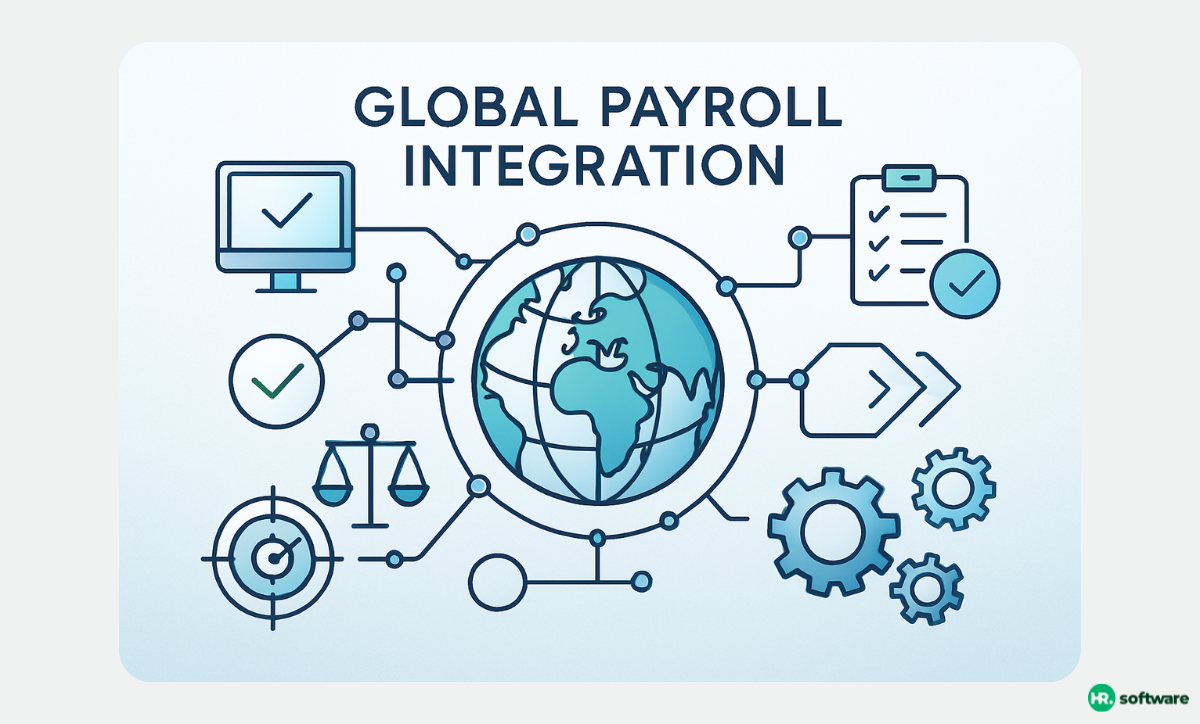.svg)

.svg)
.svg)
.svg)
.svg)
.svg)
.svg)
.svg)
.svg)



Integrations connect payroll systems with HR, finance, benefits, and compliance tools to ensure accuracy, reduce errors, and improve employee experience. Without them, payroll becomes fragmented, error-prone, and expensive.
In short, payroll integrations are not just a technical upgrade—they’re a strategic necessity for efficiency, compliance, and workforce trust.
Payroll depends on accurate employee data. HRIS platforms such as Workday, SAP SuccessFactors, and BambooHR manage the employee lifecycle—from onboarding to promotions and offboarding. By integrating HRIS with payroll, employee details like job title, salary, benefits, and tax forms automatically sync into payroll. This reduces manual entry and ensures payroll reflects the most current information. HRIS integrations also simplify compliance reporting, as workforce data and payroll records align seamlessly.
Accurate pay depends on accurate time tracking. Tools like Kronos, Deputy, TSheets, and ADP Time & Attendance capture employee hours, overtime, and leave. Integrating these with payroll ensures that timesheets flow directly into payroll calculations. This reduces disputes over hours worked, minimizes manual entry errors, and ensures compliance with overtime regulations. For global teams, integration ensures country-specific rules (e.g., mandatory breaks or maximum weekly hours) are applied correctly.
Payroll is one of the largest expenses for any organization, so integration with finance tools is critical. Platforms like Oracle NetSuite, QuickBooks, Xero, and Microsoft Dynamics align payroll with cost centers, budgets, and tax filings. Integrations allow payroll expenses to feed directly into financial statements, ensuring accurate forecasting and consolidated reporting across countries. This also supports audit readiness, as payroll records can be cross-verified with accounting entries in real time.
Benefits are often the most complex part of payroll, especially across multiple countries. Platforms like Benefitfocus, Zenefits, and Benify manage health insurance, pensions, and perks. Integrating benefits platforms with payroll automates deductions and ensures employees receive accurate benefit contributions. More importantly, integrations guarantee compliance with statutory benefits, which vary widely by country (e.g., mandatory pension contributions in the UK or healthcare in Germany).
Global payroll is inseparable from tax compliance. Tools like Avalara, Sovos, and Neeyamo Compliance Solutions automate country-specific tax calculations, filings, and reporting. These integrations ensure payroll deductions match current tax codes and that filings are submitted on time. For multinational companies, this is vital since tax rates, social contributions, and filing schedules differ across jurisdictions. Integrated compliance tools reduce the risk of costly errors and penalties.
After calculations and approvals, salaries must be paid accurately and on time. Integrating payroll with payment systems like CloudPay, Payoneer, Wise Business, and Revolut Business ensures employees are paid in their local currency at competitive exchange rates. Treasury integrations help reduce international transfer fees and manage liquidity. This is particularly useful for companies managing payroll across dozens of currencies.
Payroll data is among the most sensitive information a company holds. Integrations with systems like Okta, Azure AD, and CyberArk ensure secure access to payroll platforms. They provide single sign-on (SSO), multi-factor authentication, and role-based access controls. These integrations also help companies comply with GDPR, SOC 2, and ISO standards by enforcing strict data access policies.
End-to-end payroll integration creates a unified ecosystem across HR, finance, and compliance. It reduces errors, strengthens compliance, and improves employee experience.
For global companies, end-to-end integration transforms payroll from a back-office function into a strategic enabler of compliance and growth.
Integrations unlock value, but companies must overcome technical, regulatory, and organizational challenges.
Addressing these challenges early—with pilots, strong vendor support, and compliance audits—ensures smoother integration.
Smooth payroll integrations require careful planning, phased rollout, and strong vendor collaboration.
Here are the best practices for smooth Integrations:
By following these practices, companies minimize disruption, improve compliance, and build scalable payroll ecosystems.
Payroll is too important to be left fragmented. For global organizations, integrations are the foundation of accuracy, compliance, and efficiency. Connecting payroll with HR, finance, benefits, compliance, payments, and security ensures data flows seamlessly, errors are reduced, and employees are paid correctly every time.
Businesses considering a payroll transformation should evaluate their current systems and integration readiness before selecting a vendor. A well-planned integration strategy not only supports compliance but also future-proofs operations.
What are global payroll integrations?
They are connections between payroll and other systems (HR, finance, compliance, payments, security) that ensure data consistency, reduce errors, and automate workflows across countries.
Why do payroll systems need to integrate with HR and finance?
Payroll relies on HR data (employee records, salaries, benefits) and directly affects finance (budgets, reporting, taxes). Integrations eliminate manual updates and ensure accuracy.
Which integrations are most important for global payroll?
HRIS, finance systems, time-tracking tools, and compliance/tax software are critical. Payment and security integrations add further efficiency and protection.
How long does it take to implement a payroll integration?
Timelines vary from a few weeks for single-country pilots to 6–12 months for multi-country enterprise rollouts. Complexity depends on the number of systems and countries involved.
Are payroll integrations secure?
Yes—when implemented with security best practices like encryption, multi-factor authentication, and GDPR/SOC 2 compliance. Vendors with open APIs and certifications provide the highest assurance.